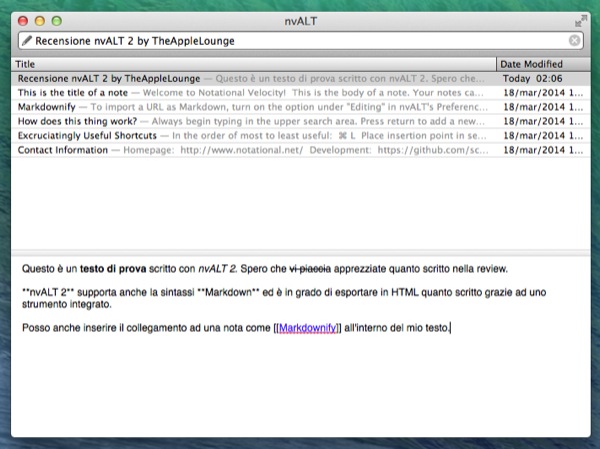

This is a feature that I use so regularly, that I don’t think I could use a note app without it. The pin function can be applied to any note. Once pinned a note always show at the top of a list, no matter how the list is sorted or how old the note is.

For work, I manage a few very large (by scope and timeframe) projects. In addition I pin some generic notes to the top of the list: Those project notes are pinned to the top. While sorting is crucial for easily accessing recent and high priority notes, I have more than I can easily browse. Most Dropbox based note apps provide search, but only by note titles. Simplenote has always provided a fast and accurate search of note content. Simplenote continues to best the competition with their search features. Not only is there content searching but the search hits are highlighted in the note view. The only problem with searching in Simplenote is that there is no way to limit searching within a single note. Simplenote performs all searching right within the app. That also means that searching is almost instantaneous for my list. Why? Because they provide context for a large flat collection of documents. Simplenote tags are a fundamental part of organizing notes. There is tag autocompletion and tag browsing built into the apps. Each note prominently displays a tag bar at the top. A note can have any combination of tags as well. Simplenote’s built in tagging system helps overcome one barrier that keeps me from uses tags in general: adding tags is generally a pain and time consuming. Tags can also be combined with searching to provide valuable combinations. I was hooked in sixty seconds.For example, I regularly search notes tagged with “work” or “personal”.
#Nvalt persistent note id archive
The Archive is €20, but you can download a sixty-day trial to check it out. I loved nvAlt, but the lack of updates, and the lack of decent text-tag support, have left me searching for an alternative. It was designed as a way to implement a note-taking system called Zettelkasten, but works beautifully for any note-taking scheme you’ve concocted. There’s more to The Archive - customizable themes, a system-wide quick-entry box - but its focus is quickly creating and finding notes, and also buildings relationships between those notes. These can be as simple or complex as you like, but once you have added one, it is listed over on the left side of the app, and clicking it instantly returns a list of all files matching the search. The Archive also supports saved searches. The name then turns into a clickable link that opens the target note. You can also link directly to another note just by typing its name, and enclosing it in double brackets. It’s a great way to collect similar notes together without having to invent a hierarchy of folders to do it. Then, in future, you can click on a tag and be shown all of your notes which contain that tag. This lets you tag your notes just by adding a #tag anywhere in the text. It uses Markdown, for instance, so you can add links and text styling to your notes. I like 1Writer, for instance, but there are many more.ĭespite using plain text, The Archive can do some clever tricks. The Archive seamlessly takes over your nvAlt directory, and if you keep the folder of notes in Dropbox or iCloud, you can sync with notes apps on iOS. This means that your notes can be opened, read, and edited by pretty much any app you like. The Archive stores each note as a separate plain text file, in the folder of your choice. Once you have tried this it’s hard to go back to any other method. If that note doesn’t yet exist, tapping enter will create it. If you made the note, it will come up as a match, and hitting enter will open it. This universal bar, then, is used both for search and for note creation.įor instance, say you’re interviewing dog walkers to take your bulldog, Rocky, out for a stroll each day. You can move through the results using the arrow keys.īut if you want to create a note, just type a new name and hit Enter. Any notes that match your search will show up (the search matches titles and contents). With The Archive open on your screen, just click into the universal bar at the top of the window (or type Command L), and start typing. In fact, you do both tasks the exact same way. That may seem obvious, but both of these functions are equally important. The Archive is for taking notes, and for searching notes. The Archive is for taking notes Don’t worry: The icons on the left can be made much less ugly.


 0 kommentar(er)
0 kommentar(er)
